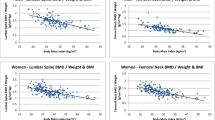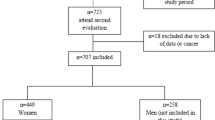Abstract
Summary
Thinness is a risk factor for fractures, but the effect of obesity on fracture risk is less clear. We found an association between measures of obesity and prevalence and number of vertebral deformities in women but not in men, in a cross-sectional study of 1,011 participants aged 50–80 years.
Introduction
Low body weight is well recognised as a risk factor for fractures, but the association between overweight and fracture risk is less well described. This cross-sectional study describes the association between measures of obesity and vertebral deformities in 1,011 male and female participants in the Tasmanian Older Adult Cohort study.
Methods
Vertebral deformities (anterior wedging) of T4–L4 were determined by morphometric dual-emission X-ray absorptiometry. Body fat was assessed as weight, body mass index (BMI), waist–hip ratio (WHR), waist circumference and DXA measures of trunk fat (in percent) and total fat mass.
Results
The mean age of participants was 63 ± 7 years, and mean BMI was 28 ± 5. Prevalent thoracic vertebral deformities were associated with increasing weight [standardised β (Sβ) 0.29, p = 0.003], BMI (Sβ 0.33, p < 0.001), trunk fat (Sβ 0.20, p = 0.03), waist circumference (Sβ 0.19, p = 0.03) and fat mass (Sβ 0.23, p = 0.03), but not the WHR in women, and only with decreasing total fat mass in men. In addition, the number of vertebral deformities increased as weight, BMI or fat mass increased in women (all p < 0.05) but decreased with increasing total fat mass in men. Associations between fat mass and vertebral deformities were mainly linear, but there was some evidence of a threshold effect in women with a BMI ≥35.
Conclusions
There is a deleterious association between increasing amounts of body fat in women but not in men and the prevalence and number of vertebral deformities, which may reflect loading of the thoracic spine.


Similar content being viewed by others
References
Johnell O, Kanis JA (2006) An estimate of the worldwide prevalence and disability associated with osteoporotic fractures. Osteoporos Int 17:1726–1733
Cooper C, O'Neill T, Silman A (1993) The epidemiology of vertebral fractures. European Vertebral Osteoporosis Study Group. Bone 14:S89–S97
Ross PD (1997) Clinical consequences of vertebral fractures. Am J Med 103:30S–42S, discussion 42S–43S
Ferrar L, Jiang G, Adams J, Eastell R (2005) Identification of vertebral fractures: an update. Osteoporos Int 16:717–728
Roux C, Fechtenbaum J, Kolta S, Briot K, Girard M (2007) Mild prevalent and incident vertebral fractures are risk factors for new fractures. Osteoporos Int 18:1617–1624
Pongchaiyakul C, Nguyen ND, Jones G, Center JR, Eisman JA, Nguyen TV (2005) Asymptomatic vertebral deformity as a major risk factor for subsequent fractures and mortality: a long-term prospective study. J Bone Miner Res 20:1349–1355
Daniell HW (1976) Osteoporosis of the slender smoker. Vertebral compression fractures and loss of metacarpal cortex in relation to postmenopausal cigarette smoking and lack of obesity. Arch Intern Med 136:298–304
De Laet C, Kanis JA, Oden A et al (2005) Body mass index as a predictor of fracture risk: a meta-analysis. Osteoporos Int 16:1330–1338
Ensrud KE, Lipschutz RC, Cauley JA, Seeley D, Nevitt MC, Scott J, Orwoll ES, Genant HK, Cummings SR (1997) Body size and hip fracture risk in older women: a prospective study. Study of Osteoporotic Fractures Research Group. Am J Med 103:274–280
Johnell O, O'Neill T, Felsenberg D, Kanis J, Cooper C, Silman AJ (1997) Anthropometric measurements and vertebral deformities. European Vertebral Osteoporosis Study (EVOS) Group. Am J Epidemiol 146:287–293
Edelstein SL, Barrett-Connor E (1993) Relation between body size and bone mineral density in elderly men and women. Am J Epidemiol 138:160–169
Sowers MF, Kshirsagar A, Crutchfield MM, Updike S (1992) Joint influence of fat and lean body composition compartments on femoral bone mineral density in premenopausal women. Am J Epidemiol 136:257–265
Beck TJ, Petit MA, Wu G, LeBoff MS, Cauley JA, Chen Z (2009) Does obesity really make the femur stronger? BMD, geometry, and fracture incidence in the women's health initiative-observational study. J Bone Miner Res 24:1369–1379
Hsu YH, Venners SA, Terwedow HA et al (2006) Relation of body composition, fat mass, and serum lipids to osteoporotic fractures and bone mineral density in Chinese men and women. Am J Clin Nutr 83:146–154
Zhao LJ, Liu YJ, Liu PY, Hamilton J, Recker RR, Deng HW (2007) Relationship of obesity with osteoporosis. J Clin Endocrinol Metab 92:1640–1646
Reid IR (2008) Relationships between fat and bone. Osteoporos Int 19:595–606
Zhao LJ, Jiang H, Papasian CJ, Maulik D, Drees B, Hamilton J, Deng HW (2008) Correlation of obesity and osteoporosis: effect of fat mass on the determination of osteoporosis. J Bone Miner Res 23:17–29
Corbeil P, Simoneau M, Rancourt D, Tremblay A, Teasdale N (2001) Increased risk for falling associated with obesity: mathematical modeling of postural control. IEEE Trans Neural Syst Rehabil Eng 9:126–136
Berrigan F, Simoneau M, Tremblay A, Hue O, Teasdale N (2006) Influence of obesity on accurate and rapid arm movement performed from a standing posture. Int J Obes (Lond) 30:1750–1757
Hue O, Simoneau M, Marcotte J, Berrigan F, Dore J, Marceau P, Marceau S, Tremblay A, Teasdale N (2007) Body weight is a strong predictor of postural stability. Gait Posture 26:32–38
Goulding A, Jones IE, Taylor RW, Manning PJ, Williams SM (2000) More broken bones: a 4-year double cohort study of young girls with and without distal forearm fractures. J Bone Miner Res 15:2011–2018
Skaggs DL, Loro ML, Pitukcheewanont P, Tolo V, Gilsanz V (2001) Increased body weight and decreased radial cross-sectional dimensions in girls with forearm fractures. J Bone Miner Res 16:1337–1342
Dimitri P, Wales JK, Bishop N (2010) Fat and bone in children: differential effects of obesity on bone size and mass according to fracture history. J Bone Miner Res 25:527–536
Premaor MO, Pilbrow L, Tonkin C, Parker RA, Compston J (2010) Obesity and fractures in postmenopausal women. J Bone Miner Res 25:292–297
Kim KC, Shin DH, Lee SY, Im JA, Lee DC (2010) Relation between obesity and bone mineral density and vertebral fractures in Korean postmenopausal women. Yonsei Med J 51:857–863
Pirro M, Fabbriciani G, Leli C, Callarelli L, Manfredelli MR, Fioroni C, Mannarino MR, Scarponi AM, Mannarino E (2010) High weight or body mass index increase the risk of vertebral fractures in postmenopausal osteoporotic women. J Bone Miner Metab 28:88–93
Gnudi S, Sitta E, Lisi L (2009) Relationship of body mass index with main limb fragility fractures in postmenopausal women. J Bone Miner Metab 27:479–484
Nielson CM, Marshall LM, Adams AL, Leblanc ES, Cawthon PM, Ensrud K, Stefanick ML, Barrett-Connor E, Orwoll ES (2010) BMI and fracture risk in older men: the osteoporotic fractures in men (MrOS) study. J Bone Miner Res 26(3):496–502
Owusu W, Willett W, Ascherio A, Spiegelman D, Rimm E, Feskanich D, Colditz G (1998) Body anthropometry and the risk of hip and wrist fractures in men: results from a prospective study. Obes Res 6:12–19
Ross PD, Davis JW, Epstein RS, Wasnich RD (1991) Pre-existing fractures and bone mass predict vertebral fracture incidence in women. Ann Intern Med 114:919–923
Flegal KM, Carroll MD, Ogden CL, Curtin LR (2010) Prevalence and trends in obesity among US adults, 1999–2008. JAMA 303:235–241
Walls HL, Wolfe R, Haby MM, Magliano DJ, de Courten M, Reid CM, McNeil JJ, Shaw J, Peeters A (2009) Trends in BMI of urban Australian adults, 1980–2000. Public Health Nutr 13(5):631–638
Zaninotto P, Head J, Stamatakis E, Wardle H, Mindell J (2009) Trends in obesity among adults in England from 1993 to 2004 by age and social class and projections of prevalence to 2012. J Epidemiol Community Health 63:140–146
Eastell R, Cedel SL, Wahner HW, Riggs BL, Melton LJ 3rd (1991) Classification of vertebral fractures. J Bone Miner Res 6:207–215
MIMS Australia (2009) MIMS annual. CMPMedica, St Leonards
Scott D, Blizzard L, Fell J, Jones G (2009) Ambulatory activity, body composition, and lower-limb muscle strength in older adults. Med Sci Sports Exerc 41:383–389
Jones G, White C, Nguyen T, Sambrook PN, Kelly PJ, Eisman JA (1996) Prevalent vertebral deformities: relationship to bone mineral density and spinal osteophytosis in elderly men and women. Osteoporos Int 6:233–239
Daniels SR, Khoury PR, Morrison JA (2000) Utility of different measures of body fat distribution in children and adolescents. Am J Epidemiol 152:1179–1184
Pouliot MC, Despres JP, Lemieux S, Moorjani S, Bouchard C, Tremblay A, Nadeau A, Lupien PJ (1994) Waist circumference and abdominal sagittal diameter: best simple anthropometric indexes of abdominal visceral adipose tissue accumulation and related cardiovascular risk in men and women. Am J Cardiol 73:460–468
Ferrar L, Jiang G, Armbrecht G, Reid DM, Roux C, Gluer CC, Felsenberg D, Eastell R (2007) Is short vertebral height always an osteoporotic fracture? The Osteoporosis and Ultrasound Study (OPUS). Bone 41:5–12
Ferrar L, Roux C, Reid DM, Felsenberg D, Gluer CC, Eastell R (2011) Prevalence of non-fracture short vertebral height is similar in premenopausal and postmenopausal women: the osteoporosis and ultrasound study. Osteoporos Int. doi:10.1007/s00198-011-1657-3
Lyritis GP, Mayasis B, Tsakalakos N, Lambropoulos A, Gazi S, Karachalios T, Tsekoura M, Yiatzides A (1989) The natural history of the osteoporotic vertebral fracture. Clin Rheumatol 8:66–69
Pollintine P, Luo J, Offa-Jones B, Dolan P, Adams MA (2009) Bone creep can cause progressive vertebral deformity. Bone 45:466–472
Acknowledgements
We especially thank the participants who made this study possible, and we gratefully acknowledge the role of TasOAC staff and volunteers in collecting the data, particularly research nurses Catrina Boon and Pip Boon. Tisha Carter and Rose Ford conducted the densitometry. We thank the Health IT team, particularly Tim Albion and Alistair Chilcott for their expertise in converting the MXA data into a useable format.
Conflicts of interest
None.
Author information
Authors and Affiliations
Corresponding author
Additional information
The TasOAC study was supported by the National Health and Medical Research Council of Australia, Arthritis Foundation of Australia, Tasmanian Community Fund, Masonic Centenary Medical Research Foundation, Royal Hobart Hospital Research Foundation, and University of Tasmania Institutional Research Grants Scheme. Laura Laslett is supported by an Australian Government Australian Postgraduate Award during her doctoral candidature. She received a travel grant to present this work to the Australian and New Zealand Bone and Mineral Society Annual Scientific Meeting in 2010. Graeme Jones is a National Health and Medical Research Council practitioner fellow. Tania Winzenberg is supported by the Osteoporosis Australia Australian and New Zealand Bone and Mineral Society/Amgen Fellowship. Stella Just (nee Foley) is supported by the Australian Government Australian Postgraduate Award and the Ruby Menzies Scholarship.
Rights and permissions
About this article
Cite this article
Laslett, L.L., Just nee Foley, S.J., Quinn, S.J. et al. Excess body fat is associated with higher risk of vertebral deformities in older women but not in men: a cross-sectional study. Osteoporos Int 23, 67–74 (2012). https://doi.org/10.1007/s00198-011-1741-8
Received:
Accepted:
Published:
Issue Date:
DOI: https://doi.org/10.1007/s00198-011-1741-8




